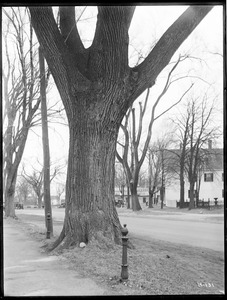Ulmus americana Massachusetts (Hingham)
Item Information
- Title:
- Ulmus americana Massachusetts (Hingham)
- Title (alt.):
-
Tree habit with woman
- Description:
-
Ulmus americana Massachusetts (Hingham) The Cushing Elm.
- Photographer:
- Wilson, Ernest Henry, 1876-1930
- Collector:
- Wilson, Ernest Henry, 1876-1930
- Date:
-
November 11, 1923
- Format:
-
Photographs
- Genre:
-
Glass negatives
- Location:
- Arnold Arboretum Horticultural Library
- Collection (local):
-
Photographs of Ernest Henry Wilson
- Series:
- New England Trees
- Subjects:
-
Elms
American elm
- Places:
-
Massachusetts > Plymouth (county) > Hingham
- Extent:
- 1 negative : glass ; 20.5 x 15.5 cm.
- Permalink:
- https://ark.digitalcommonwealth.org/ark:/50959/1r66j327s
- Terms of Use:
-
(c) President and Fellows of Harvard College. Arnold Arboretum Archives. Permission to publish archival materials and / or images in a publication, performance, or broadcast must first contact the library for permission < hortlib@arnarb.harvard.edu >. Our policies and forms for use of the library and archival materials can be accessed at http://arboretum.harvard.edu/library/services/
All rights reserved.
- Notes (historical):
-
(M-9) The Cushing Elm is situated near Cape Cod, when one passes through the portion of Hingham lying just south of Nantasket Junction near the Cohasset town line. It is situated on East Street, on what was called the “Rocky Nook.” (Pane-Joyce Genealogy website: http://aleph0.clarku.edu/~djoyce/gen/report/rr05/rr05_178.html). Aesthetically, The Cushing Elm was considered by many to be a very large and symmetrical tree. E.H. Wilson’s characteristic photographic style of creating a composition with a centrally-placed tree and a small figure next to it to show scale accentuates its celebrated symmetry and size. Similar to the Washington Elm, the Cushing Elm has an extremely colorful and patriotic history. The Daughters of the American Revolution put the following inscription on the tree: “Under this tree in 1775/Pastor John Brown preached to a company of Cohasset soldiers/ of Col. Greaton’s Regiment which/ Served in the siege of Boston” (Simmons, “The Cushing Elm,” in The Historic Trees of Massachusetts, pp. 26-27).It is called the Cushing Elm because it is named after Captain Stephen Cushing, who planted the tree in 1729. Stephen Cushing, who was a farmer, proprietor of a large landed estate, and selectman by trade, lived across the street from the tree, having inherited an old colonial house from his father Peter Cushing who died at age 28 in 1715. Initially the tree was planted on the Cushing’s property, but it was eventually transplanted across the street from the Cushing residence (Simmons 28-29). On July 25, 1839, the tree measured 13 feet in circumference, and the branch span at its fullest was over 90 feet. There were 8 large main branches, and it was 60-70 feet tall, according to George B. Emerson, who measured the tree in the company of botanist William Oakes, who probably served as an eyewitness (Simmons 29-30). In 1919, when Simmons’ book was published, the dimensions increased considerably. He said that only one of the 8 main branches died, the spread of the branches was over 100 feet, and the circumference was 16.5 feet (Simmons 30). In the photographic detail of the Cushing Elm (M-10), one of the main branches is clearly severed at the left.
- Accession #:
-
13272
- Identifier:
-
AAW-009
M-9




